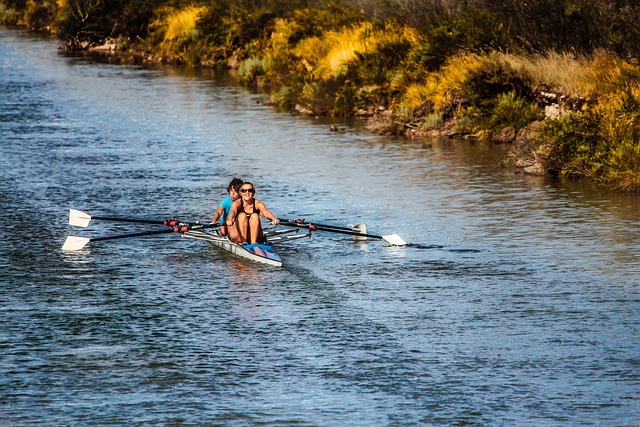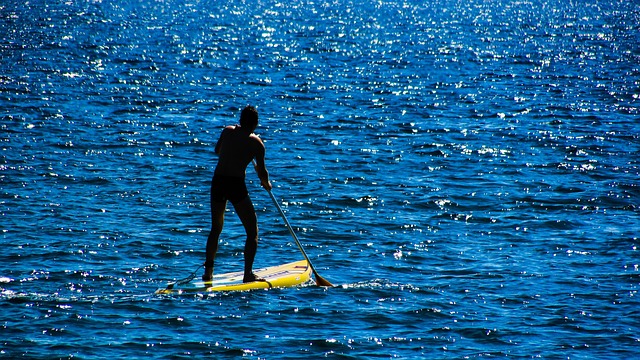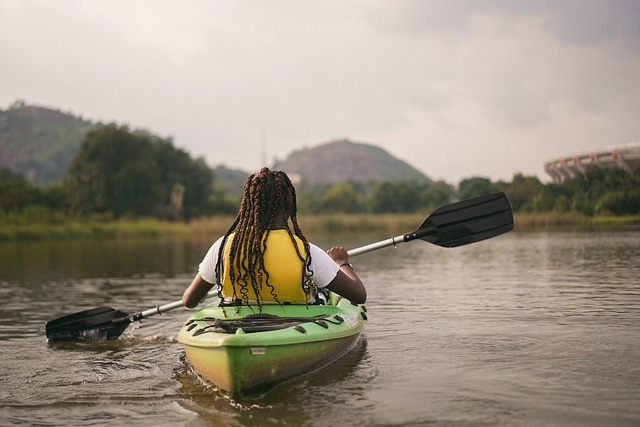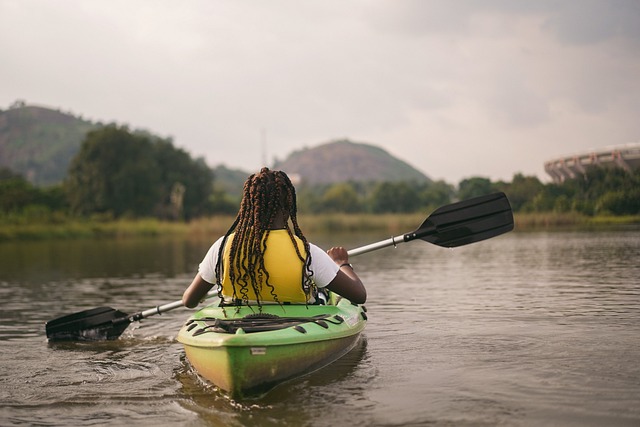Inflatable Paddle Boards (IPBs) have revolutionized water sports by offering a versatile, accessible option suitable for all skill levels. Their lightweight design, quick inflation/deflation times, and stable weight distribution make them ideal for various water conditions. IPBs cater to beginners and experienced paddlers, providing recreational fun or exciting races. Key factors in selecting an IPB include size, shape, construction material, weight capacity, and safety features like robust air chambers and easy-to-use pumps. Setting up requires investing in a high-quality board suited to your skill level and water conditions, along with essential safety gear and accessories for convenient transport and storage. Beginners should focus on mastering basic paddling techniques, while advanced enthusiasts can learn dynamic strokes to enhance speed and control. Prioritizing safety through knowledge of local regulations, marine life, weather, and wearing a properly fitted life jacket is paramount.
“Discover the thrilling world of water sports with a stable platform that has taken the industry by storm—the inflatable paddle board (IPB). This versatile sport is gaining popularity due to its accessibility and convenience. In this comprehensive guide, we explore the rise of IPBs, from their benefits like portability to choosing the right board and essential gear. Learn beginner techniques, advanced tips, and safety practices, making your water adventure a memorable one. Get ready to paddle, explore, and embrace the freedom of inflatable paddle boarding!”
The Rise of Inflatable Paddle Boards: A Popular Water Sport Choice

The rise of inflatable paddle boards (IPBs) has transformed the water sports landscape, offering a stable platform for enthusiasts of all skill levels. These innovative boards have gained immense popularity due to their versatility and accessibility. Unlike traditional rigid paddle boards, IPBs are easy to transport and store, making them an ideal choice for recreational paddlers and those new to the sport. Their lightweight construction and quick inflation/deflation times enable users to set out on the water in minutes, enjoying a peaceful paddle or engaging in exciting races.
With advancements in materials science, modern IPBs provide exceptional stability and maneuverability, rivaling their rigid counterparts. They are equipped with durable, high-pressure air chambers that distribute weight evenly, ensuring a stable platform even in choppy waters. This feature makes them suitable for various water conditions, from calm lakes to gentle waves, appealing to both experienced paddlers seeking new challenges and beginners looking to explore the joys of stand-up paddleboarding (SUP).
Benefits of Inflatable Paddle Board: Portability and Accessibility

Inflatable paddle boards (IPBs) offer a unique advantage in terms of portability and accessibility, making them a popular choice for water sports enthusiasts. Their lightweight design allows for easy transport and storage, as they can be deflated and packed into compact sizes, fitting conveniently into car trunks or even larger backpacks. This portability enables users to access various water bodies, from serene lakes to rugged rivers, without the usual constraints of lugging around heavy equipment.
With an IPB, getting out on the water becomes more accessible and convenient than ever. Whether you’re a beginner looking for a fun recreational activity or an experienced paddler exploring new waterways, these boards provide a flexible option. They can be quickly inflated and deflated, allowing users to set off on their adventures at a moment’s notice, without the need for extensive preparation or specialized equipment.
Choosing the Right Inflatable Paddle Board: Factors to Consider

When selecting an inflatable paddle board (IPB), several key factors come into play to ensure a stable and enjoyable water sports experience. First, consider the size and shape; longer boards offer more stability and speed while shorter ones are easier to maneuver for beginners. Material is another critical aspect; durable, high-quality PVC or fiberglass construction guarantees longevity and performance in various water conditions.
Weight capacity should align with your intended use and physical strength. Some IPBs cater to solo users, while others support multiple riders. Additionally, the addition of accessories like built-in carry handles, storage compartments, or a fin system can enhance convenience and control. Always opt for boards with robust air chambers for safety, as well as an easy-to-use pump for quick inflation and deflation.
Setting Up for Success: Essential Gear and Accessories

Setting up for water sports, especially with an inflatable paddle board (IPB), requires the right gear to ensure a safe and enjoyable experience. The first step is to invest in a high-quality IPB suitable for your skill level and preferred water conditions. Look for sturdy construction, optimal buoyancy, and a design that aligns with your intended use—be it surfing, fishing, or casual paddling. Alongside this, secure a reliable paddle designed for comfort and performance, as well as a robust pump to easily inflate and deflate your board.
Don’t forget essential safety gear such as a life jacket or vest, especially in open waters. Wetsuits are also beneficial for colder climates, providing insulation and enhancing your visibility if capsized. Proper footwear is crucial too; water shoes or sandals with good grip prevent slipping on slippery surfaces. Lastly, consider accessories like dry bags to protect valuables, and a portable carrier or rack for easy transport and storage of your gear.
Mastering the Basics: Techniques and Tips for Beginners

Water sports enthusiasts, especially those new to the scene, often look for a stable platform to enhance their experience. An inflatable paddle board (IPB) is an excellent choice for beginners due to its versatility and ease of use. Mastering the basics on an IPB involves understanding proper paddling techniques and maintaining balance.
For first-timers, learning to paddle efficiently is key. Using a long, smooth stroke while keeping your body relaxed can help you cover more distance with less effort. Maintaining a steady grip on the board and keeping your eyes forward ensures stability. Remember, it’s better to start slow and focus on technique rather than rushing into complex moves. Regular practice on calm waters will quickly improve your skills, making you confident enough to explore different water sports activities.
Advanced Techniques: Taking Your Inflatable Paddle Boarding to the Next Level

Taking your inflatable paddle boarding (IPB) skills to new heights involves embracing advanced techniques that go beyond the basics. One such technique is the ‘switch stroke’, where experienced paddlers alternate their dominant side, adding a dynamic twist to their paddling motion. This skill not only enhances balance but also allows for faster and more efficient propelling, making it a favorite among IPB enthusiasts.
Another innovative approach is incorporating advanced turns and maneuvers. The ‘J-stroke’ is a popular technique that enables precise turning and control. By adjusting the angle of the paddle and its placement in the water, paddlers can create a powerful force that guides the inflatable board with remarkable agility. Mastering these advanced techniques opens up new possibilities for IPB enthusiasts, transforming their outdoor adventures into thrilling, skill-enhancing experiences.
Safety First: Guidelines and Best Practices for Water Sports Enthusiasts

Water sports enthusiasts must always prioritize safety, especially when participating in activities like stand-up paddle boarding (SUP) or using inflatable paddle boards. Before hitting the water, familiarize yourself with local regulations and warnings regarding rip currents, marine life, and weather conditions. Wearing a properly fitted life jacket is non-negotiable, offering vital protection against drowning.
Additionally, learning basic water safety skills and first aid can make a significant difference in emergency situations. Being aware of your physical limitations and staying within your comfort zone is crucial. Always paddle with a buddy, ensuring someone else is present to assist if needed. Regularly maintaining and inspecting your inflatable paddle board for any signs of damage or wear is also essential for both safety and performance.
